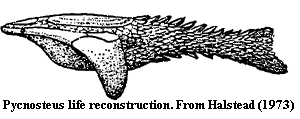 Pycnosteidae: Ganosteus, Pycnolepis, Pycnosteus, Tartuosteus (= Psammolepis?), Yoglinia. Probably the base of the Middle Devonian radiation of psammosteidans.
Pycnosteidae: Ganosteus, Pycnolepis, Pycnosteus, Tartuosteus (= Psammolepis?), Yoglinia. Probably the base of the Middle Devonian radiation of psammosteidans.| Pteraspidomorphi | ||
| The Vertebrates | Psammosteida (2) |
| Vertebrates Home | Vertebrate | Vertebrate |
Abbreviated Dendrogram
Vertebrata
├─Conodonta
└─┬─Thelodonti
│
└─Pteraspidomorphi
├─Arandaspida
└─Heterostracomorphi
├─Astraspidae
└─Heterostraci
├─Cyathaspidiformes
│ ├─Cyathaspidida
│ └─Amphiaspidida
└─Pteraspidiformes
├─Pteraspididae
└─Psammosteida
├─Drepanaspis
└─┬─Guerichosteidae
└─┬─┬─Pycnosteidae
│ └─Psammolepis
└─Psammosteidae |
Contents
Overview |
Guerichosteidae: Guerichosteus, Hariosteus, Schizosteus
Range: Early Devonian to Middle Devonian (possibly Late Devonian) of Europe
Phylogeny: Psammosteida:: (Pycnosteidae + Psammolepis) + Psammosteidae) + *.
Characters: Oral plates narrow relative to Drepanaspis [T64]; postorbital plate tapers gradually posteriorly [T64]; branchial plates wider than Drepanaspis, "and their lateral parts are solid and free" [T64]; branchial plates drawn out as sheets laterally and downturned [T64]; cornual plates rectangular [T64]; branchial opening at or medial to posterolateral corner [T64]; ventral median plate convex [T64]; median ventral plate with wide, open posterior notch [T64]; very clear concentric lines of growth in median plates [T64]; development of small, accessory dentine tubercles between main dentine tubercles [T64]; fresh water [H73].
References: Halstead 1973) [H73]; Tarlo (1964) [T64].
Notes: Rather poorly known. ATW020111.
 Pycnosteidae: Ganosteus, Pycnolepis, Pycnosteus, Tartuosteus (= Psammolepis?), Yoglinia. Probably the base of the Middle Devonian radiation of psammosteidans.
Pycnosteidae: Ganosteus, Pycnolepis, Pycnosteus, Tartuosteus (= Psammolepis?), Yoglinia. Probably the base of the Middle Devonian radiation of psammosteidans.
Range: Middle Devonian to Late Devonian of Europe.
Phylogeny: Psammosteida:::: Psammolepis + *.
Characters: postorbital elongated [T64]; branchial plates enlarged by successive lines of growth [H73]; branchial plates shortened and extended laterally to form large, thin down-turned "wings" [H73] [T64]; branchial plates show wear on anterior surface, as well as equally on dorsal and ventral surfaces [H73] [T64]; anterior marginal of branchial plate wings anteriorly concave (as in image) in some species [T64]; ventral median plates, long, thin and elaborated ventrally as sled-like runners [H73]; ventral plates show wear in middle region (suggesting horizontal position -- mouth well above substrate) [H73]; deep median ventral plate with long shallow groove forming almost flat ventral surface with very steep sides laterally and anteriorly [T64]; notch behind branchial plates filled in, in some forms (Tartuosteus) by more tesserae [H73] (? [T64] says groove in median ventral plate is filled in -- which makes more sense); major plates show continuing concentric growth [H73]; major plates also show some growth by accretion of tesserae [2] [T64].
Halstead 1973) [H73], Tarlo (1964) [T64].
Note: [1] [H73] suggests that Pycnosteus cruised through vegetation, knocking small invertebrates loose and filtering them. [2] This evidence comes from Tartuosteus as stated in [T64]. Tartuosteus may actually be a species of Psammolepis; but, then again, Psammolepis may turn out to be a pycnosteid.... ATW020111.
 Psammolepis: Psammolepididae) Largest (?) of the psammosteidans.
Psammolepis: Psammolepididae) Largest (?) of the psammosteidans.
Range: Middle Devonian to Late Devonian of Europe, Russia & North America.
Phylogeny: Psammosteida::: Pycnosteidae + *.
Characters: Growth by addition of tesserae, with growth lines (rings of ornament) on major plates progressively smaller [H73]; subsequent growth by progressive enlargement of component units (tesserae?) of major plates, rather than concentric growth of whole plate (i.e., growth by accretion of tesserae begins to dominate over concentric growth of plates) [H73] [T64]; median plates become covered with tesserae [H73] [T64].
Halstead 1973) [H73]; Tarlo (1964) [T64].
Image: Psammolepis venyukovi from [T64]. See Psammosteida for plate nomenclature. 020111.
Psammosteidae: Cranosteus (Crenosteus?), Karelosteus, Psammosteus, Rohonosteus. The last heterostracans, from the uppermost Frasnian.
Range: Late Devonian of Europe, Russia & North America
Phylogeny: Psammosteida::: Pycnosteidae + Psammolepis) + *.
Characters: major median plates covered with superficial tesserae (probably ontogenetic process as in Psammolepis) [H73]; dorsal median plate highly variable, i.e. flat to concave, but usually with gently curving lateral margin and relatively broad flat keel [T64]; very long postorbitals [T64]; branchial plates extremely short and wide to become "just solid arcuate plates forming the posterolateral corners of the carapace" [T64]; Psammosteus may have been sexually dimorphic in width of dorsal median plate [H73]; in Psammosteus, branchial plates may have been moveable [H73]; branchial plates with elongated tesserae covering proximoventral surface [T64]; branchial plate distal end with distinct wear facets (suggesting it was moveable) [T64]; growth largely by progressive enlargement of component units (tesserae?) of major plates, rather than concentric growth of whole plate [H73].
Document Gallica (French)
Halstead 1973) [H73], Tarlo (1964) [T64].
Note: [1] Document Gallica is a complete, indexed .pdf of Eichwald's (1860) treatise on Russian fossils, with an extraordinary amount of detail on Psammosteus. Notwithstanding Halstead's [T64] high opinion of this work, the information is omitted because (a) the author evidently thought Psammosteus was a placoderm (b) the genus has been reorganized and redescribed a number of times since, so that the continuing validity of the material referred to Psammosteus by Eichwald is unclear; and, mostly, (c) my French is not up to accurate translation of 19th century anatomical or histological terms. 020111.
checked ATW060104